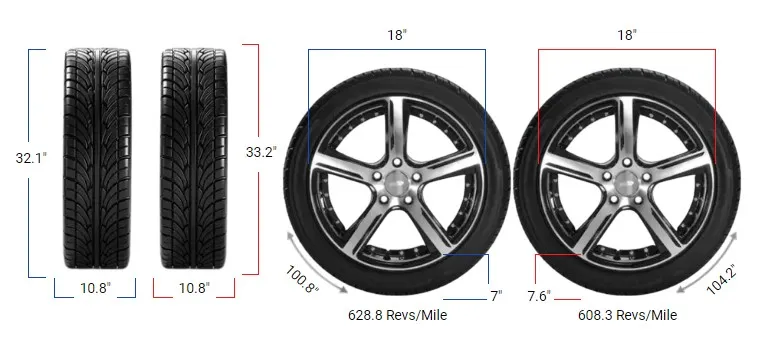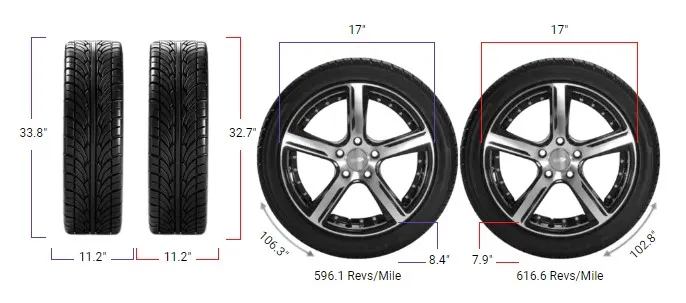Tire Size 185/65r15 vs 195/65r15

Tire upgrades can enhance your vehicle’s performance and appearance. Let’s explore the switch from 185/65r15 to 195/65r15 tires, examining the impacts on your driving experience both on and off the road.
- Tire width increases by 10mm improving grip and stability
- Overall diameter grows by 2.1% falling within the 3% acceptable range
- Ground clearance rises by approximately 6.5mm
- Speedometer will underreport actual speed by about 2%
- Slightly larger contact patch may enhance cornering performance
- Fuel efficiency might decrease marginally due to increased rolling resistance
- Vehicle appearance becomes more aggressive with wider tires
- Ride comfort may improve due to increased sidewall height

Fitment Guide
The overall diameter difference between the two tire sizes is 2.1%, well within the acceptable 3% range.
This means the interchange is recommended and should not require significant vehicle modifications. However, it’s always wise to consult with a tire professional to ensure proper fitment for your specific vehicle model.
On-Road Impact
On-road performance is where most drivers will notice the effects of switching to 195/65r15 tires. Let’s examine the key areas affected by this change:
- Handling and Grip: The wider 195mm tire offers a larger contact patch with the road. This can translate to improved traction, especially during cornering and in wet conditions. Drivers may notice a slight increase in stability and confidence when making quick maneuvers.
- Ride Comfort: The 5.4% increase in sidewall height (from 120.25mm to 126.75mm) provides a bit more cushioning between the wheel and the road. This extra rubber can absorb minor road imperfections, potentially resulting in a smoother ride.
- Speedometer Accuracy: The 2.1% increase in overall diameter affects the tire’s revolutions per mile. At a speedometer reading of 20 mph, your actual speed will be 20.42 mph. While this difference is small, it’s worth noting that your vehicle will be traveling slightly faster than indicated.
- Fuel Efficiency: The larger, heavier tire may have a minor negative impact on fuel economy. The increase in rolling resistance and overall weight could result in a slight decrease in miles per gallon, though this difference would likely be negligible for most drivers.
- Aesthetics: The wider tire fills out the wheel well more, giving the vehicle a slightly more aggressive and sporty appearance. This can be particularly noticeable on smaller cars.
- Noise: The wider tread pattern may generate slightly more road noise, especially at higher speeds. However, the difference is usually minimal and may not be noticeable to most drivers.

Off-Road Impact
While the 185/65r15 to 195/65r15 switch is more common for on-road use, it can have some effects on light off-road performance. Here’s what to expect when venturing off the pavement:
- Ground Clearance: The new tire’s diameter is 13mm (0.51 inches) larger, increasing ground clearance by about 6.5mm (0.26 inches). This modest boost can help with clearing small obstacles and reducing the risk of undercarriage damage on rough terrain.
- Traction: The wider tread of the 195mm tire can provide better grip on loose surfaces like gravel or sand. However, the difference is relatively small and may not be significant for most light off-road situations.
- Flotation: In soft conditions like mud or snow, the wider tire may offer slightly improved flotation. This can help prevent the vehicle from sinking as deeply, potentially reducing the chances of getting stuck.
- Durability: The larger sidewall of the 195/65r15 tire may offer a bit more protection against impacts with rocks or other obstacles. This could potentially reduce the risk of sidewall damage during light off-road use.

What is the Difference Between 185/65r15 and 195/65r15?
The primary difference between 185/65r15 and 195/65r15 tires is the width. The new tire is 10mm (0.39 inches) wider, increasing from 185mm to 195mm.
This 5.4% width increase provides a larger contact patch with the road, potentially improving grip and stability.
185/65r15 vs 195/65r15 Table
This comparison helps identify the key performance differences between 185/65R15 and 195/65R15 tire sizes.
| Feature | 185/65R15 | 195/65R15 | Difference |
|---|---|---|---|
| Diameter inches (mm) | 24.47 (621.5) | 24.98 (634.5) | 0.51 (13) +2.1% |
| Width inches (mm) | 7.28 (185) | 7.68 (195) | 0.39 (10) +5.4% |
| Circumference inches (mm) | 76.87 (1952.5) | 78.48 (1993.34) | 1.61 (40.84) +2.1% |
| Sidewall Height inches (mm) | 4.73 (120.25) | 4.99 (126.75) | 0.26 (6.5) +5.4% |
| Revolutions per mile (km) | 824.25 (512.16) | 807.36 (501.67) | -16.89 (-10.49) -2% |
| Speedo Reading | 20 mph | 20.42 mph | +0.42 mph |
Can I Use 195/65r15 Instead of 185/65r15?
Yes, you can use 195/65r15 instead of 185/65r15. The overall diameter difference is 2.1%, which is within the recommended 3% limit for tire replacement.
This makes the switch generally safe and feasible without requiring significant vehicle modifications.
How Much Taller Is a 195/65r15 Tire Than a 185/65r15?
A 195/65r15 tire is 13mm (0.51 inches) taller than a 185/65r15 tire. The overall diameter of the 185/65r15 is 24.47 inches (621.5mm), while the 195/65r15 has a diameter of 24.98 inches (634.5mm). This represents a 2.1% increase in height.
Our Observation
Switching from 185/65r15 to 195/65r15 tires offers a blend of benefits with minimal drawbacks. The wider tread enhances grip and stability, while the slightly larger diameter improves ground clearance and ride comfort.
These advantages come with only minor trade-offs in fuel efficiency and speedometer accuracy. For most drivers, the performance gains will outweigh the negligible negative impacts.
However, it’s crucial to ensure proper fitment and be aware of the small speedometer discrepancy. Overall, this tire upgrade provides a subtle but noticeable improvement in both on-road handling and light off-road capability, making it a worthwhile consideration for many vehicle owners.



